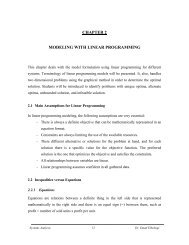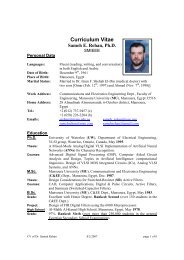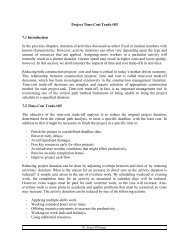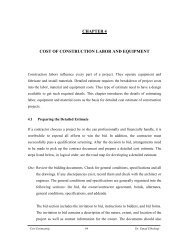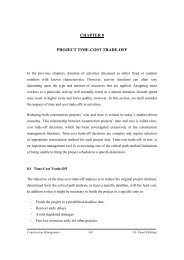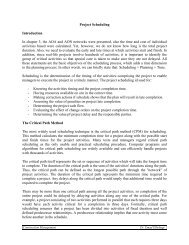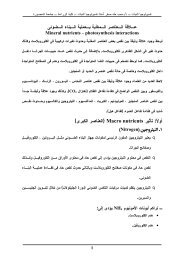Thyroid and Parathyroid
Thyroid and Parathyroid
Thyroid and Parathyroid
Create successful ePaper yourself
Turn your PDF publications into a flip-book with our unique Google optimized e-Paper software.
MEN patients to have more than four functioning gl<strong>and</strong>s, a thorough exploration <strong>and</strong><br />
a transcervical thymectomy should be a routine part of the operation. It is not<br />
. uncommon for these patients to have five or six parathyroid gl<strong>and</strong>s<br />
HYPERCALCEMIC CRISIS<br />
Hypercalcemic crisis represents the life-threatening systemic condition brought on by<br />
.( elevated serum calcium levels (generally 13.0 mg/dL or higher<br />
Clinical Manifestations<br />
Symptoms are varied <strong>and</strong> range from neuromuscular changes with mild fatigue <strong>and</strong><br />
irritability to coma. Signs of dehydration are prominent. Gastrointestinal<br />
manifestations include anorexia, nausea, vomiting, <strong>and</strong> weight loss. Cardiac<br />
dysrhythmias, most commonly secondary to a shortened Q-T interval, may occur <strong>and</strong><br />
can be lethal. Cancer cachexia may be evident in patients presenting with skeletal<br />
metastases. A palpable neck mass in the face of hypercalcemic crisis is considered a<br />
parathyroid carcinoma until proved otherwise. Therapy is initiated before attempting<br />
. to differentiate the cause of hypercalcemia<br />
The list for the differential diagnosis is theoretically long, with any cause of<br />
hypercalcemia included, but in the vast majority (more than 90 percent) of cases it<br />
. comes from advanced malignancy or primary hyperparathyroidism<br />
Treatment<br />
Intravenous saline resuscitation is started <strong>and</strong> advanced to achieve a diuresis of higher<br />
than 100 mL/h. Dehydration is prominent with hypercalcemic crisis, <strong>and</strong> volume<br />
resuscitation (often 4 to 5 L) is the cornerstone of therapy. Once the patient appears<br />
adequately hydrated <strong>and</strong> urine output is more than 1 mL/kg/h, loop diuretics are given<br />
to stimulate a natriuresis <strong>and</strong> subsequent calciuresis. Cardiac dysrhythmias typically<br />
resolve with hydration <strong>and</strong> the subsequent decrease in the serum calcium level.<br />
Should dysrhythmias persist or become symptomatic, they are treated with st<strong>and</strong>ard<br />
agents for dysrhythmia. When hypercalcemia persists in the face of aggressive<br />
resuscitation <strong>and</strong> diuresis, the addition of mithramycin, phosphate binders (e.g.,<br />
pamidronate), vitamin D, estrogen, calcitonin, or steroids may be useful.<br />
Hypercalcemia in patients with advanced malignancy <strong>and</strong> skeletal metastases can be<br />
. difficult to normalize<br />
Patients with hyperparathyroidism usually can be stabilized with simple hydration <strong>and</strong><br />
diuresis. Identification of a cervical mass on physical examination in the face of<br />
hypercalcemic crisis foreshadows a diagnosis of parathyroid carcinoma. Vocal cord<br />
function should be checked <strong>and</strong> the diagnosis of malignancy discussed with the<br />
patient. Ultrasonography may be useful while resuscitation is under way, or in the rare<br />
patient who is critically ill from persistent hypercalcemia. If a large adenoma is<br />
identified, hypercalcemia can be resolved quickly with a focused exploration <strong>and</strong><br />
parathyroidectomy. With hemodynamic stability, regardless of the results of<br />
ultrasonography, operative intervention is undertaken early in patients with primary<br />
hyperparathyroidism. If the diagnosis of primary hyperparathyroidism is secure, even<br />
in comatose patients or in those with hemodynamic instability despite volume<br />
resuscitation, operative intervention should not be delayed. Postoperative transient<br />
hypocalcemia is common, <strong>and</strong> frequent calcium assessment is prudent because of the<br />
.<br />
previous instability of these patients



